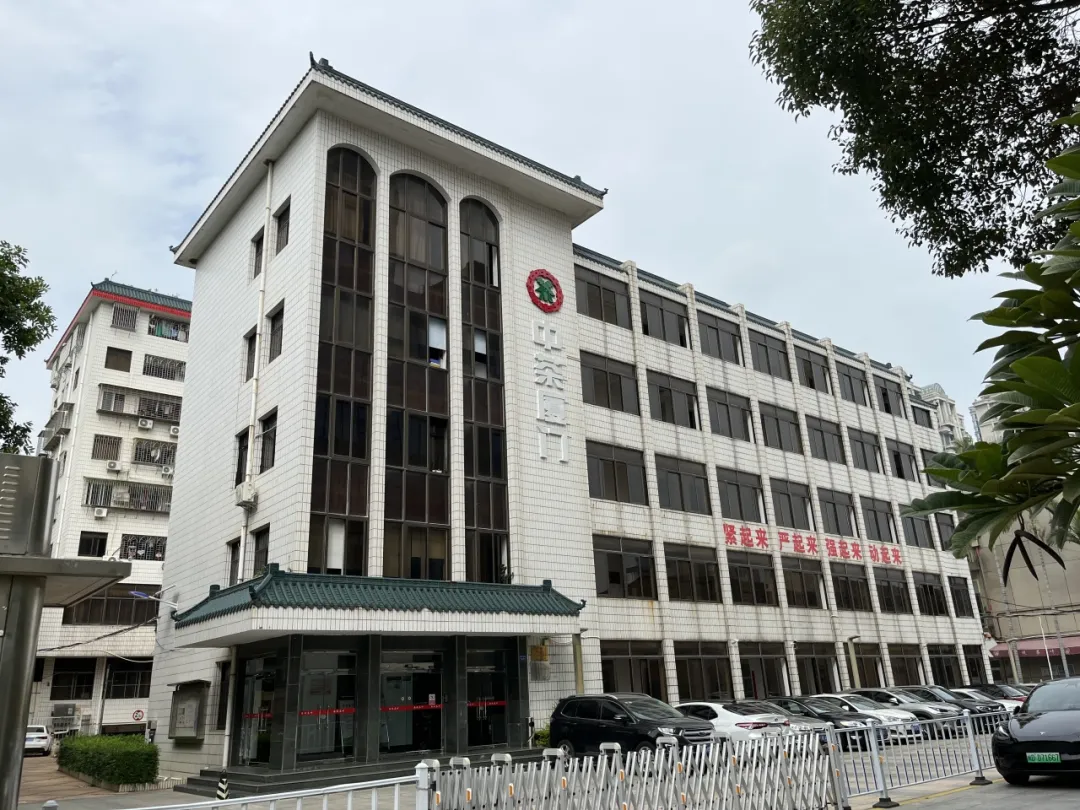At the 70th Anniversary of the Company | Seadyke Story (Episode One): The Beginning China Tea (Xiamen), Nov.12, 2024
① Rooted in this Land: Tea and Xiamen, An Indissoluble Bond
Fujian has a long history of tea production, and the written records began with Lu Yu's "The Classic of Tea (Cha Jing)" in the Tang Dynasty. During the Northern Song Dynasty, Fujian's tea industry had developed to its heyday. At that time, Jianzhou Beiyuan Tea and Tianxin Rock Dahongpao from Wuyi Mountain were famous internationally. During Longqing period of the Ming Dynasty, Zhangzhou Yuegang was opened as the only official foreign trade port. As the outlet of Yuegang port, Xiamen became an important gateway of the "Maritime Silk Road", and the tea trade began to develop rapidly.

↑The busy Xiamen in early 20th century
Since Qing Dynasty, Xiamen was the main port for the export of Fujian Oolong Tea. From mid-17th century, a large amount of Fujian teas exported via Xiamen Port mainly were sourced from Wuyi Mountain, Anxi, Jianning and other tea producing areas, such as Taiwan. They were going to Vietnam, Singapore, the Philippines and other overseas countries. There was a time of period that the annual export volume of Oolong tea reached 10,000 or even nearly 100,000 kilograms. Tea produced in southern Fujian, such as Zhangquan Oolong tea and Anxi Tieguanyin, and Taiwan Oolong tea, were mostly exported through Xiamen Port and shipped to Europe and America.
The prosperity of tea exports had raised the flourishing tea business in Xiamen. There was a very dense distribution of specialized tea shops (also known as tea houses and tea stores) in Xiamen, integrating procurement, processing, transportation and sales. In that era, tea shops were a "scenery" of Xiamen's business. All the shop front was particularly decorated and the inside furnishings were quite delicate...
The popularity of tea drinking in Xiamen had also spawned various tea houses and the unique "the-little-tea-table". Since late Qing Dynasty and the early Republic of China, it had become a distinctive scenario. From the first wharf to Xiamen Port, from Haikou to Heshan, streets and alleys, the "little-tea-table", a kind of side-table looking, short and small table, was almost everywhere. People would love to sit around the table killing hours to chat for lives, talk bout businesses, settle disputes, and even meet for matchmaking.
Time has changed, Xiamen people still can recall those fragrances that has permeated this city. Dahongpao, Tieluohan, Shuixian, Laocong Shuixian, Sanyin Shuixian, Wuyi Qizhong, Mingzhong, Liuxiang Xiaozhong, Tieguanyin, Huangjingui, Yizhichun, Mingxiang, Zhengxi Tea, Foshou, Zhongmo Tea...

In the 70 years of dedication, Xiamen Tea Imp.&Exp. Co., Ltd. has been cultivating its name "Seadyke" deeply rooted, for inheriting the prosperous history of the tea trade in Xiamen, but also taking part in the development of tea industry in southern Fujian after the foundation of the new China.
② Company established: In the new era
Xiamen is the kind of city converted from a port. Tea market relying on seaport traffics had undergone several ups and downs. As a famous station for the transportation of tea during the Maritime Silk Road, Xiamen Port had transferred tea to Indonesia and other places as early as the early 17th century. Oolong tea shipped from Xiamen was once popular in Europe and America, and as the "Tea for Chinese Overseas", had gained great popularity in Southeast Asia.
After Xiamen becoming one of the "five seaports opening gates of China" in late Qing Dynasty, the tea markets in the city were once activated. In the first half of the 20th century, Xiamen's tea industry was in its golden time, and in 1923, a Tea Guild for tea dealers established in Xiamen. However, the trades were in a time of period of fallen until the beginnings for the new China. The tea businesses of the city had got its reopening and been recovered there after. During that historical time, China Tea (Xiamen) came into being.

↑Former Site of The Tea Guild of Xiamen (established in 1923)
Photo Stories:
A 1954-1956: China Tea Fujian Branch, Xiamen Office
On November 23, 1949, the first national specialized tea company, China Tea, was established in Beijing. It was the first international trading company of the new China.

▲The site of old office at No. 122 Zhongshan Rd.
B 1957-1961: China Tea Fujian Branch, Xiamen Tea Export Company
In the second half of 1956, companies in Xiamen dealing intentional trade were moved one after another in one building at No. 38 Haihou Road. Then, China Tea Xiamen Office had renamed as Xiamen Tea Export Co.

▲Left: in 1950s to 1960s, the "Foreign Trade Building"on Lujiang Road, Haikou, Xiamen, where the office of Xiamen Tea Export Co. was located; Right: the old office site in the 1960s.
C 1962-1980: China Tea Fujian Tea Import and Export Company, Xiamen Branch
On January 1, 1961, China Tea Export Co. merged with China Native Products Export Co. , the new company was mainly dealing the import and export businesses of tea and native products. In November 1962, Xiamen company was renamed and In 1965, the parent company changed the name into China National Tea Imp. and Exp. Corporation. In 1976, the company exported 3 tons of Tieguanyin to Japan for the first time.

▲In November 1964, Seadye tea products from Xiamen Tea were advertised in Singapore newspaper
D 1980-1991: China Tuhsu Fujian Tea Import and Export Corporation, Xiamen Branch
In January 1980, Xiamen Branch got its new name China Tuhsu Fujian Tea Import and Export Corporation, Xiamen Branch. In 1984, after the opening of tea trade in China, China Tea (Xiamen) launched an outlet, "Xiamen Tea Imp.& Exp. Trading Center", at No. 28, Shuixian Road. This franchise store was for selling Seadyke tea products solely.

▲Mr.Zhang Shuicun, the store manager of the tea outlet in Shuixian Rd.
E 1991-1998: Fujian Xiamen Tea Import & Export Corporation
In 1991, there was the new company name Fujian Xiamen Tea Import & Export Corporation. The company was in charge of tea production and sales. In the same year, it had implemented a trial policy, of which the wages should be linking with company performances.
F 1999 to Present: Xiamen Tea Import & Export Co., Ltd.
On November 10, 1999, after the restructuring, Xiamen Tea Imp. & Exp. Co., Ltd. was officially established. In the historical times, from the early days of the new China to the 1980s, before the tea business was liberalized, China Tea (Xiamen) had been witnessing and been participating in along with the changes of the tea production and processing in Xiamen. The company had made great contributions to Fujian Oolong tea trade.

▲The present office at No. 160 Hubin Zhong Rd)
③ Origin of "Seadyke": “Amoy Sea Walls Spirit” and "Seadyke Tea"
The “Seadyke (pronounced as ‘sea dike’)” initially was applied to the products of China Tea (Xiamen) in 1960. it has a touching story which is closely related to the "Amoy Sea Walls Spirit".
In mid-December of 1950, the location from Gaoqi Wharf through Xiaoyu to Jimei Beach for this national miracle was selected. The embankment was drafted about two kilometers long and commended to construct on June 17, 1953.
In January 1954, it’s in full construction. On October 15, the first phase of the project was opened to traffic half a month ahead of the schedule, and the entire line was opened to traffic on December 10, 1954. In October 1955, the whole project finished.
In memory of this spectacular engineering across the sea, the "Amoy Sea Walls Monument" was erected in Xiamen Gaoqi dike on October 1, 1955.

▲the Amoy Sea Walls Project
During the two-year’s construction, tens of thousands of builders stepping on the stormy waves, reclaimed land from sea to build this sea dike. They overcame numerous difficulties, and fearlessly created the miracle. When tea products of China Tea (Xiamen) was entitled "Seadyke", the little tiny leaf also undertakes its responsibility, carrying the inheritance of the "Amoy Sea Walls Spirit". Those Spirits are: "loving your country and hometown, selfless dedication, fearless of difficulties, removing mountains and filling seas, exploiting and innovating, and arduous pioneering".






 EN
EN
 AR
AR NL
NL FR
FR IT
IT JA
JA KO
KO PT
PT RU
RU ID
ID MS
MS